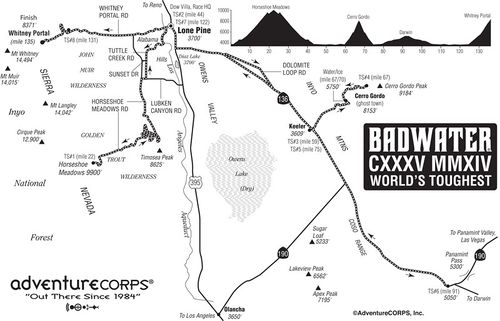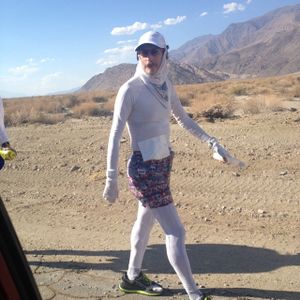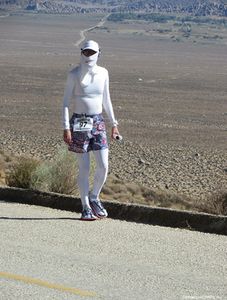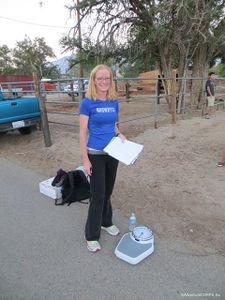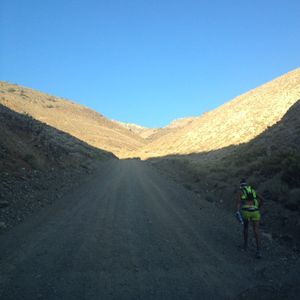Difference between revisions of "2014 Badwater 135"
From Fellrnr.com, Running tips
User:Fellrnr (User talk:Fellrnr | contribs) (Created page with "The 2014 Badwater 135 course map and elevation profile. Badwater is one of the best known and toughest ultramarathons. ...") |
User:Fellrnr (User talk:Fellrnr | contribs) |
||
| Line 21: | Line 21: | ||
* '''My Crew'''. A good crew is essential for Badwater success, and I had a wonderful group. Nathan was my crew chief, and he recruited the people who have crewed him on ultras before. This meant the crew knew each other well and had worked together under similar difficult high pressure situations. Nathan, Alice, Steve, and Ken worked together flawlessly | * '''My Crew'''. A good crew is essential for Badwater success, and I had a wonderful group. Nathan was my crew chief, and he recruited the people who have crewed him on ultras before. This meant the crew knew each other well and had worked together under similar difficult high pressure situations. Nathan, Alice, Steve, and Ken worked together flawlessly | ||
* '''My Pacer'''. Nathan also doubled as my main pacer for 75 miles of the race. Nathan is a psychology professor and a great conversationalist, so we had lots to talk about. Ken, Alice and Steve all took turns pacing me for a few miles, which they did with aplomb. | * '''My Pacer'''. Nathan also doubled as my main pacer for 75 miles of the race. Nathan is a psychology professor and a great conversationalist, so we had lots to talk about. Ken, Alice and Steve all took turns pacing me for a few miles, which they did with aplomb. | ||
| − | * '''Heat Training'''. All the [[Heat Acclimation Training]] paid off nicely and I didn't suffer any heat illness during the race. I probably did far more heat training than I needed to, but | + | * '''Heat Training'''. All the [[Heat Acclimation Training]] paid off nicely and I didn't suffer any heat illness during the race. I probably did far more heat training than I needed to, but I figured too much was better than not enough. |
* '''Downhill'''. The [[Downhill Running]] paid huge dividends, protecting my legs and keeping me far stronger. | * '''Downhill'''. The [[Downhill Running]] paid huge dividends, protecting my legs and keeping me far stronger. | ||
* '''Altitude Training'''. My [[DIY Altitude Training]] seemed to work well. Without it I do badly at altitude, seemingly worse than most people. The altitude training would have been more effective if I'd been able to increase my iron intake soon enough, but even with iron supplements my iron levels (serum ferritin) was too low. | * '''Altitude Training'''. My [[DIY Altitude Training]] seemed to work well. Without it I do badly at altitude, seemingly worse than most people. The altitude training would have been more effective if I'd been able to increase my iron intake soon enough, but even with iron supplements my iron levels (serum ferritin) was too low. | ||
* '''Hydration'''. My [[DIY Electrolyte Drink]] worked perfectly, keeping me hydrated and my electrolytes in balance. | * '''Hydration'''. My [[DIY Electrolyte Drink]] worked perfectly, keeping me hydrated and my electrolytes in balance. | ||
| − | * '''Fueling'''. My only fuel was | + | * '''Fueling'''. My only fuel was Ensure drinks which I had about every 2-3 miles. Amazingly they were still tasting good at the end of the race, and were even palatable when a little warm. While my [[Fellrnr's Go Juice| Go Juice]] is better, the simplicity of the Ensure makes it a better choice for this type of race. |
| − | * '''Napping'''. I took a 30 minute and a 10 minute nap during the race, which helped keep the sleep deprivation in check. | + | * '''Napping'''. I took a 30 minute and a 10 minute nap during the race, which helped keep the sleep deprivation in check. The 30 minute came at around mile 75, after Cerro Gordo and was a planned nap to keep me going. The 10 minute nap was at about mile 110 and was one I had to take to keep functioning. |
* '''Clothing'''. I covered up completely to protect from the sun, wearing tights, long sleeved top, fingerless gloves and a hat with a neck and face cover. | * '''Clothing'''. I covered up completely to protect from the sun, wearing tights, long sleeved top, fingerless gloves and a hat with a neck and face cover. | ||
| − | * '''Shoes'''. I wore the [[Altra One2]] for the first 45 miles, then the [[Altra Olympus]] for 45 miles, | + | * '''Shoes'''. I wore three different types of shoe for the race. I wore the [[Altra One2|Altra One<sup>2</sup>]] for the first 45 miles, and their light weight was great on the ascent and descent from Horseshoe Meadows. I then swapped to the [[Altra Olympus]] for 45 miles. They worked remarkably well, but at mile 90 my feet were hurting so much that I figured a change might help. I wore the [[Hoka Bondi]] for the next 32 miles, before reverting to the Olympus for the finish. After the race I realized that the heat of Badwater had worn down the Bondi dramatically. I had more wear in 32 miles of Badwater than I'd expect from 300 miles of normal use. The One<sup>2</sup>.had also worn, but not as badly as the Bondi. The Olympus still look new, probably because the Olympus has an outsole over most of its sole. |
* '''Watch'''. I used [[Best Running Watch| Suunto Abmit2R]] and with GPS recording set to one minute intervals it was still going strong at the end of 37 hours. Knowing the distance and elevation helped me visualize were I was in the race and my progress. This proved to be far more valuable mentally than I expected. | * '''Watch'''. I used [[Best Running Watch| Suunto Abmit2R]] and with GPS recording set to one minute intervals it was still going strong at the end of 37 hours. Knowing the distance and elevation helped me visualize were I was in the race and my progress. This proved to be far more valuable mentally than I expected. | ||
=What Didn't Work= | =What Didn't Work= | ||
Revision as of 10:54, 25 July 2014
Badwater is one of the best known and toughest ultramarathons. Even though I've done many 100 mile races, plus pacing at Badwater last year, the difficulty of the race still managed to surprise me.
Contents
1 What happened
The race went well given the difficulty, and I ran conservatively to maximize my chances of finishing.
- To Horseshoe Meadows (mile 23). The first section of the race is a steady climb to 10,000 ft/3,000m and the stunningly beautiful views kept me entertained. I could feel the effects of the altitude, and my breathing was more strained than I'd expect. I checked my SpO2 at the top and it was 80-85%, rising to just over 90% as I recovered and got my breath back. That's lower than I'd have liked, but not a problem.
- To Lone Pine (mile 45). The 6,000ft/1,800m descent back to Lone Pine has the potential to trash your quads, so my main goal was to minimize muscle damage. Of course, taking it easy on that type of descent is a 8:00 min/mile pace, which was nice. I'd have loved to have pushed the pace on the descent, but I'd have ended up much slower by the end of the race.
- To Keeler (mile 59). The journey to Keeler was flat, hot and uneventful. I picked up Nathan, my pacer, at Lone Pine and he stayed with me to Darwin.
- To Cerro Gordo (mile 69). The path to the ghost town at Cerro Gordo the only part of Badwater that does not allow for crew access, so we had to carry all our supplies. We started up the path at sunset, and the night sky was exquisite as we were so far from any street lights. The 7.5 mile path up the mountain averages a 12% grade, but the last 2.5 miles is steeper and felt like it was 20% or more. This is the one part of the race where I was not sure I would make it, as I felt as bad as I've ever felt on a race. At the time I thought it was altitude sickness, but given that I was fine going up Whitney portal, I'm not sure. (I'd left my pulse oximeter behind. Doh!)
- To Keeler (mile 75). I felt immediately better as we started to descend, though the steepness was tough on the quads and the feet.
- To Darwin (mile 91). I slept for 30 minutes at the foot of Cerro Gordo which helped a little with the sleep deprivation. The sunrise was wonderful, as "second dawn" always is, but the temperature rose rapidly. The slight rise to Darwin seemed interminable as my exhausted mind thought that Darwin should be much closer.
- To Lone Pine (mile 122). Most of return trip to Lone Pine was a nice descent that I put to good use, but just past Keeler I started to crash a little. I took a 10 minute nap, then slowed up and focused on fueling more. By this point the sleep deprivation was causing mild hallucinations, but these were a pleasant distraction and nothing like the legendary hallucinations that Badwater is famous for.
- To Whitney Portal (mile 135).For the last section, you hear the mantra "just a half marathon to go" quite a bit, but it seems like it's so much further. I go some blisters under my left forefoot, something that rarely happens to me, and my feet felt like I was walking on burning coals. Nathen joined me again at Lone Pine, and kept me on pace for the ascent. Our timing was perfect in many ways as we were late enough in the day to do the steepest part of the ascent in the shade of the mountain, but still finish in daylight. My final time was 36:46:30 for 39th place.
2 The Difficulty
The toughness of Badwater is not any single factor, but rather the way these factors combine.
- The extra 35 miles beyond the 100 mile distance is more than 35% more difficult because fatigue is cumulative. Consider that at mile 85 in a 100 miler, the end would be in sight, but at Badwater there's still another 50 miles to go. I've run 130-146 miles in 24 hour races a few times, but a 24 hour race generally provides optimal running conditions.
- The heat causes several problems. There's the critical problem of overheating and getting heat illness, which normally involves the vomiting that compounds the problems. But even if you avoid overheating, the heat means a much slower pace than would be possible in the cool, making the race take much longer.
- The long descents tear up the muscles, further slowing progress. Even if you're well prepared and take things carefully (which I did), there is some unavoidable damage. I had far more muscle damage from Badwater than my previous 100 milers.
- The above factors mean the race takes a lot longer and so sleep deprivation becomes a problem. I didn't find sleepiness too much of a problem, but the deprivation did cause mild hallucinations and intoxication.
3 What Worked
- My Crew. A good crew is essential for Badwater success, and I had a wonderful group. Nathan was my crew chief, and he recruited the people who have crewed him on ultras before. This meant the crew knew each other well and had worked together under similar difficult high pressure situations. Nathan, Alice, Steve, and Ken worked together flawlessly
- My Pacer. Nathan also doubled as my main pacer for 75 miles of the race. Nathan is a psychology professor and a great conversationalist, so we had lots to talk about. Ken, Alice and Steve all took turns pacing me for a few miles, which they did with aplomb.
- Heat Training. All the Heat Acclimation Training paid off nicely and I didn't suffer any heat illness during the race. I probably did far more heat training than I needed to, but I figured too much was better than not enough.
- Downhill. The Downhill Running paid huge dividends, protecting my legs and keeping me far stronger.
- Altitude Training. My DIY Altitude Training seemed to work well. Without it I do badly at altitude, seemingly worse than most people. The altitude training would have been more effective if I'd been able to increase my iron intake soon enough, but even with iron supplements my iron levels (serum ferritin) was too low.
- Hydration. My DIY Electrolyte Drink worked perfectly, keeping me hydrated and my electrolytes in balance.
- Fueling. My only fuel was Ensure drinks which I had about every 2-3 miles. Amazingly they were still tasting good at the end of the race, and were even palatable when a little warm. While my Go Juice is better, the simplicity of the Ensure makes it a better choice for this type of race.
- Napping. I took a 30 minute and a 10 minute nap during the race, which helped keep the sleep deprivation in check. The 30 minute came at around mile 75, after Cerro Gordo and was a planned nap to keep me going. The 10 minute nap was at about mile 110 and was one I had to take to keep functioning.
- Clothing. I covered up completely to protect from the sun, wearing tights, long sleeved top, fingerless gloves and a hat with a neck and face cover.
- Shoes. I wore three different types of shoe for the race. I wore the Altra One2 for the first 45 miles, and their light weight was great on the ascent and descent from Horseshoe Meadows. I then swapped to the Altra Olympus for 45 miles. They worked remarkably well, but at mile 90 my feet were hurting so much that I figured a change might help. I wore the Hoka Bondi for the next 32 miles, before reverting to the Olympus for the finish. After the race I realized that the heat of Badwater had worn down the Bondi dramatically. I had more wear in 32 miles of Badwater than I'd expect from 300 miles of normal use. The One2.had also worn, but not as badly as the Bondi. The Olympus still look new, probably because the Olympus has an outsole over most of its sole.
- Watch. I used Suunto Abmit2R and with GPS recording set to one minute intervals it was still going strong at the end of 37 hours. Knowing the distance and elevation helped me visualize were I was in the race and my progress. This proved to be far more valuable mentally than I expected.
4 What Didn't Work
- My feet became sore quite early on in the race and by the last third were remarkably painful. It's been suggested that the heat of Badwater cooks the soles of the feet, making the pain of the continual pounding worse. The pain was a little less with the slightly firmer Altra Olympus than the Hoka Bondi, and massaging the foot seemed to provide some temporary relief.
- For the first time in many years I got blisters on my feet. The combination of socks I use has eliminated the problem in the past, which made me a little blasé. I should have changed socks far more often, cleaning and checking my feet at the same time.
- I had a problem with chafing, as even with the low humidity, some parts of the body remain constantly wet. This is combined with the fine dust and sand that acts as a skin abrasive. Smothering the area in Desitin helped a little.
- I didn't have a checklist for the ascent up Cerro Gordo, and I'd have avoided several mistakes if I used one. I didn't take enough calories up the mountain, I forgot the Pulse Oximeter and my headlight batteries were dead. Luckily the race directory happened to be coming down the mountain and bailed me out with some fresh AAAs!
- I didn't try to do a Morton Stretch until around mile 110, which was way too late. By the time I tried, I could not get my quads to stretch properly.
5 What I'd Do Differently
- The three 100 milers I did in the months prior to Badwater impacted my training more than I'd have liked and I would have been in better shape if I'd have raced less.
- I should have done more Downhill Running and less Heat Acclimation Training. The downhill seems to be the most valuable aspect of my training, and I think more would be better.
6 Gallery
More pictures to follow.
- Images from Badwater 2014
The hat that served me well at Badwater, made from a Halo hat and an old under armor running top.
